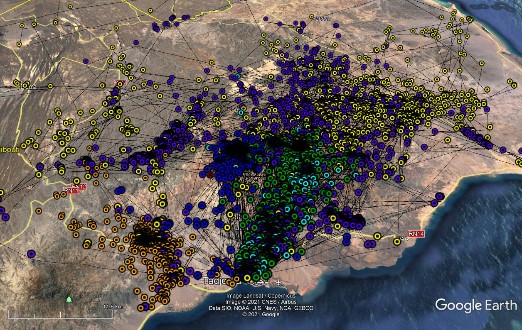In February
2020 we trapped seven adult Egyptian vultures at the Tadjoura abattoir, and
fitted them with GPS loggers. Of the
seven, at least six seem to be still active in March 2021.
One may have died, but may still be alive, but outside the GSM network. It may also have dropped its tag. The birds displayed different patterns of
behaviour. Some appeared to settle into
territories, others wandered widely, and at least one seemed to settle for
rather short periods in areas, then move on (See maps below).
Their use of the abattoir at which they were captured varied: some birds visited regularly, some
irregularly, some rarely.
The ranging
of the birds overlapped considerably (maps below), which is to be expected from scavenging
birds, even though many birds were tied to territories.
Movements during February 2020 - February 2021of 7 Egyptian vultures tagged in Djibouti
Movements during February 2020 - February 2021of 7 Egyptian vultures tagged in Djibouti, zoomed in on Tadjoura, where the vultures feed at the abattoir.
Most of the vultures were rather settled, suggesting that they were territory-holders, but one (Mabla) ranged quite widely, spending a considerable amount of time in Ethiopia. In moving across this wider landscape, Mabla crossed through an area where a wind farm is being built, raisng the possibility that the wind farm may pose a risk to Egyptian vultures. Even settled, apparent territory-holders sometimes ranged over much larger areas. The maps below show two extremes of ranging behaviour.
Movements of an adult Egyptian vulture (Goda) during February 2020 - February 2021. Goda ranged primarily between its presumed territory and the abattoir at Tadjoura.
Movements of an adult Egyptian vulture (Mabla) during February 2020 - February 2021. Mabla ranged over a very large area, including excursions lasting days or weeks into Ethiopia.















